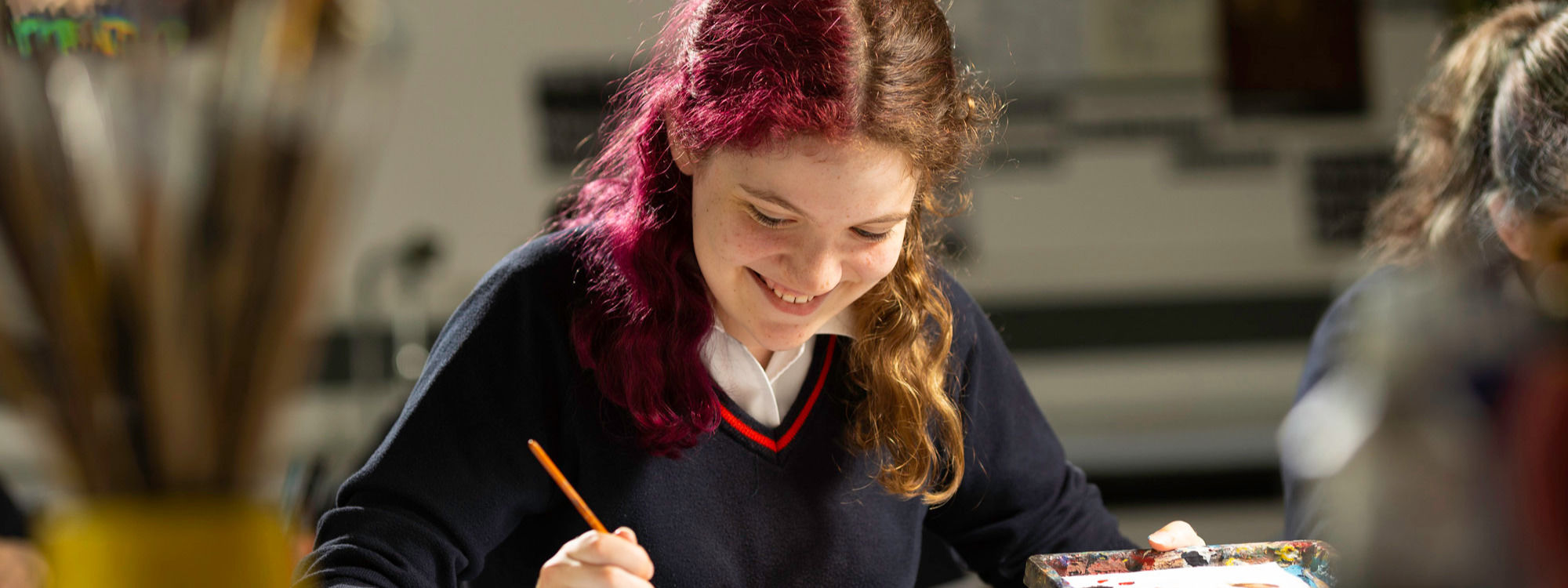Art & Design: Fine Art, Photography, Textiles
Syllabus: Pearson Edexcel GCE Art & Design A Level
1 - Why study Art?
Build your creative thinking skills, resilience and self-motivation
2 - What will you study?
Year 12
Term 1
Foundation of Skills/Disciplines
Create your own Skill/Techniques Manual
Trip to Berlin
Term 2
Theme: Transformation
25 Variations - Transforming 1 image in a multitude of media/scale/concepts
Trip to Thameside Studio –Course in Printmaking/Etching
Term 3
Developing your own project outcomes for Interim Summer Exhibition
Controlled Time 2 days plus 5 hours under controlled conditions to produce exhibition outcomes
Introduction to Personal Study Essay (Research & Reading over the Summer/Reading List shared)
Year 13
Term 1
Continue developing a body of work
Personal Study with one-to-one tutorials to support with investigative research
Component 1 Personal Study Essay
Term 2
Externally Set Assignment
Theme shared First week of February
Personal Study Portfolio Submission April
Term 3
May/June 3 days dedicated to making refined Exhibition ready outcomes.
Submit all work.
3 - How will you be assessed?
Component 1: Personal Study & Investigative research Essay (1000-3000 words) 60%
Component 2: Externally Set Assignment ( Year 2 Feb—May) 40%
Your creative journey is worth around 75% of your course and should be shared in the form of a digital portfolio/website or sketchbook. You can choose your preference.
4 - What skills will you develop?
You will experience a range of technical skills and decide which media and materials suit your way of working.
You will learn the importance of creativity with a focus on iterative art & design practices, to develop and refine your ideas and your outcomes.
You will learn how to develop investigative research skills so you can confidently talk about your own work and the work of others sharing your ideas in an essay format.
Art & Design develops:
- Creative thinking skills
- Confidence in taking risks
- Resilience in overcoming hurdles in your work
- Adaptability and the ability to view the world from different perspectives
- The ability to take your own initiative and make independent decisions
- Self-motivation and positivity
Technical Art & Design Skills
- Ceramics Busts/Heads Pots & / Relief / Pottery on the wheel/Glass work
- Painting in Oil/Acrylic/Mixed media
- Printmaking Silkscreen Printing, Etching, lino, mono
- Textiles Print design/garment making/heat press/dying techniques/fabric/textile making crochet/knitting/weave
- Transferring photographs on to different materials
- Digital Photography Setting up a Photoshoot
Slow & Fast Shutter Speed Photography
Exposures
- Darkroom Light drawing/ Cyanotypes/Photograms/Chemi-grams
- Installation - Mixed Media Art Video/Textile
- Drawing – Developing direct observational skills -Light Drawing, Life Drawing, Sewing Machine Drawing
- Digital Manipulation Software
- Animation techniques model making stop motion/digital
- Laser cutting/3D Printing/Prototyping
- Sculpture using repurposed materials/plaster/clay/textiles
5 - What makes a good Art student?
Embracing experimentation and risk taking. Being willing to explore the work of others, visiting galleries and reading selected texts introduced to you by your teachers.
Commitment to practising your skills outside of lesson time, in frees or at home to ensure you have time to produce and organise your work.
6 - Where can Art & Design lead?
1 year Art & Design Foundation course - Build your portfolio, trying out more techniques and make a clear decision about which specialist degree you would like to undertake.
A 3 year Art & Design Degree
Potential Creative Industry Jobs & Apprenticeship Degrees
- 3D design
- Ceramics designer
- Enameller
- Fashion designer
- Fine artist
- Graphic designer
- Illustrator
- Textile designer
- Spatial designer
- Advertising
- Architect
- Interior designer
- Animator
- Art gallery curator
- Arts administrator
- CAD technician
- Design and development engineer
- Marketing assistant
- Photographer
- Set designer
- Signwriter
- Visual effects director
- Cultural heritage conservator
- Historic environment advice assistant
- Post-production technical operator
- Bespoke tailor and cutter
- Archaeological specialist
7 - Reading list and preparation
Summer Project Explore the theme:
- ‘Freedom’ create an A5 sketchbook to share on the first day of the course and bring in a piece of artwork (or photograph of a piece of art you have made that you are proud of)
- Visit a gallery or museum in London
- Read John Berger’s Ways of Seeing - though written in the 1970s it is still a powerful read.
8 - Stretch and challenge resources
- Share an artist/artwork you admire and explain their way of working and its significance
- Share books that you have read and how it inspires your way of thinking and creating
- Review an art exhibition and present your findings to your peers

